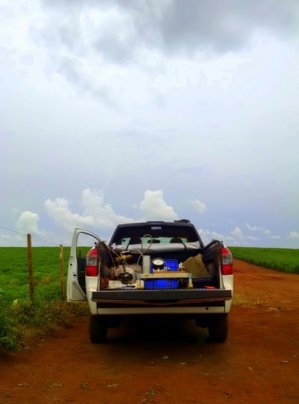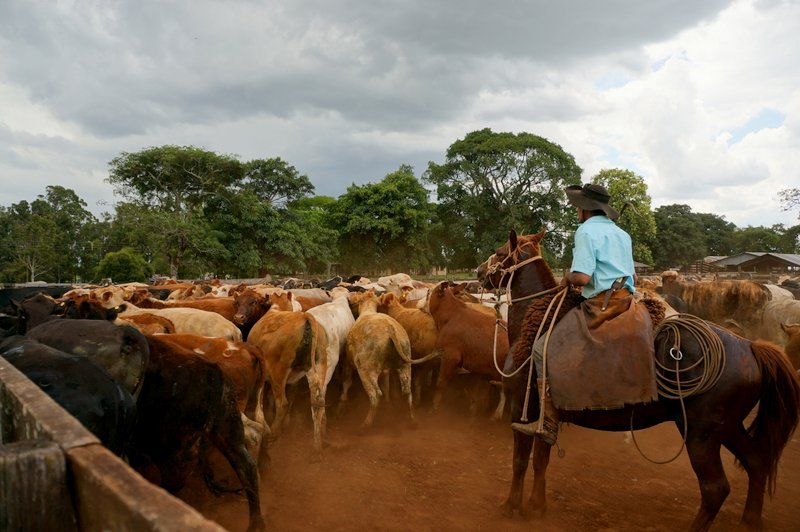Gaucho Science
The morning mist is thick and low on the ground. I’m guessing relative humidity of 100%. Vapor pressure deficit 0 kPa. Transpiration 0 mm/s. I can’t even see Pedro and Jonatas as they put together a tripod on the far end of the field. I can only hear the clunks and clangs of the aluminum pipes as they slide into the iron tripod joint.
The higher note of the hammer sings as it strikes the stakes, pulling the guy lines firm. One by one the long masts holding the sensor heads pop into view, until finally all six poke lamely into the heavy atmosphere above the soybean canopy. So much metaphor potential it’s almost too easy.
I am in Rio Grande do Sul, Brazil, the country’s southernmost state and home of the Gauchos, those quintessential South American cowboys. Espinilho Ranch, some 8 hours’ drive from the state capital of Porto Alegre, produces thousands of hectares of beef cattle and soybeans and is my field site for the Brazilian summer. I have been here since October, foolishly trying to do plant physiology while counting on the cooperation of the weather. The tripods and the adorable little sensors attached to them are all part of my clever (again, read: foolish) plan to track vegetation indices throughout the day, looking for signs of stress in the crop when the weather heats up.
Back at my bunk at ranch headquarters, the morning’s data collection finished, I tear through my book and check social media and the New York Times obsessively. Every few minutes a pause to survey the sky and the gathering clouds while prowling around the farm yard. Current events have me preoccupied, to say the least; in the time it has taken for the soybeans to grow from seedlings to knee-high plants, my future as a young, optimistic scientist has grown considerably murkier. I’m a government-funded researcher, but the government cares not for my work.
Frigging rain. What direction is the wind blowing? Will we even be able to go to the field this afternoon? Of course, we have to go, there are soil samples to collect from today and yesterday. We go. I send Pedro and Jonathas off with the shovel, while I head to a distant field with the sampling rings, a hammer, and a smaller trowel. The day’s work has an extra interest to it due to Paulo’s promised visit later in the afternoon, such a rare occurrence that I am anxious to demonstrate the slickness of my operation. Paulo, something of a demi-god in the world of Brazilian animal and crop science, has spearheaded a great deal of research on crop-livestock integration, and I’m here at his invitation.
He arrives at just the moment when I’m thrashing around in the soybeans trying to hammer my sampling rings into the ground. Sweaty and with mud all the way up my arms. Hat askew, hair flying around because my cheap sunglasses have rubber bits on the ear pieces that stick to my hair and pull strands out of my pony tail every time I take them off. Looking every bit like a slick operation. Then the storm clouds that I have been watching warily for the past hour decide to make their entrance, and within five minutes of Paulo’s arrival conditions have deteriorated drastically. I suddenly begin to fear for our safety and the safety of my precious sensors, exposed as they are in this open field, inescapably attached to very tall and very metallic tripods. Minor chaos commences.
Pedro, Jonatas and I scramble to pull the sensor rigs from the tripod bases, jumbling strings, wires, and protective covers together, rushing to throw old raincoats over the more sensitive equipment in the truck bed as the rain begins pelting down, all while Paulo and his two traveling companions stand watching bemusedly, trying to stay out of the way and getting soaked to their proverbial boxer shorts in the process. The equipment stowed as well as possible, I manage to direct a shrug and a wry grin in Paulo’s direction. He hides a giggle behind his dripping mustache, seeming to enjoy the show immensely.

For all its size and dominance in sectors like agriculture, Brazil spends only 1.4% of its GDP on research and development, putting it well below the global average of 2.1%. Things had been gradually improving for science in recent years, until the economic crisis of 2013 sent research funding straight back to the bottom of the government’s agenda. The state of Rio Grande do Sul recently dropped its agricultural research program, FEPAGRO – just, dropped it, along with its zoobotanical and science and technology programs – leaving its scientists scrambling to find replacement positions in industry or academia. Newly minted PhDs are obliged to look outside the country for employment, resulting in an exodus of Brazil’s most highly educated human resources. Even one of Brazil’s best-funded universities, the Federal University of Rio de Janeiro, has professors in limbo waiting for promised grant money to arrive, and a supercomputer that’s not running for want of a simple repair.
Back at ranch headquarters again, huddling in the meal room. The drips from our wet clothes becoming puddles under the wooden benches. Jonatas prepares mate for everyone, and for once I’m grateful for the bitter, hot beverage. Paulo reveals he has brought a present: a grape cuca, pound cake frosted with sugary fruit, a great favorite of Rio Grandenses. I offer the tin full of wild passion fruits that I found down by the creek the day before. Brief skepticism, then delight as they find the tiny fruits to be sweet and refreshing. In any case, there are few treats to be found at Espinilho, and we munch happily on cake and passion fruit while taking sips of steaming mate.
In the intervening weeks I have asked my Brazilian friends, how do you do it? How do you keep writing papers, collecting data, with an institutional environment that regards research – and especially agricultural research – as a non-priority? Their reliable answer is to look elsewhere. To not rely on the government, and to rely instead on connections and collaborations, on the private sector, on a broad national and international network, on people rather than institutions. I have since begun to suspect that one of Paulo’s top strategies for keeping the machines oiled is to simply say “yes” twice as often as he says “no”. He regards research not as mere work, but as a mission, a way of life, and a duty to his students. “Good research doesn’t always require expensive equipment or facilities,” he says. “Just brains, and willingness.”
I am not alone in wondering where things are headed. My future as an ecologist may seem up for grabs, but my Brazilian friends face similar, perhaps even graver, difficulties. Still, they produce science. They invite me to exchange ideas and work in their fields, they lend their time, their hands, and their data to help me towards our mutual benefit. Nothing went at all as I had hoped today – quite the contrary. But we sit together, we share food and drink, we speak not a word of politics, and their solid presence makes me feel more secure.
A scientific community that faces outward, not inward, and that holds generosity and trust in the highest regard, thrives independent of transient policy environments. We are not the first nor the only ones to have our research disrupted by capricious rainclouds, and any case, uncertainty does not preclude action. We can meet it with creativity and persistence, continuing to build bridges with what bricks we have. After all, Gaucho scientists have been doing it for years.
Read the original article in The Aggie Brickyard Winter 2017 issue


